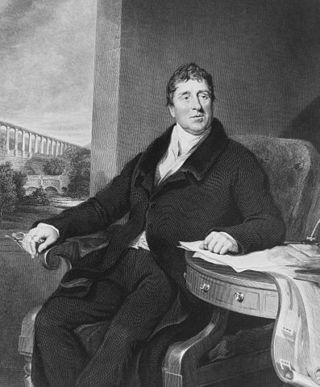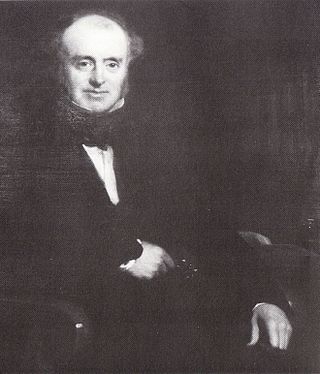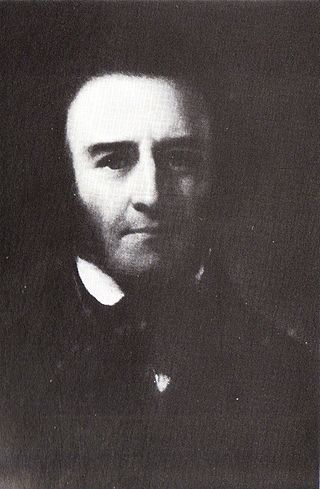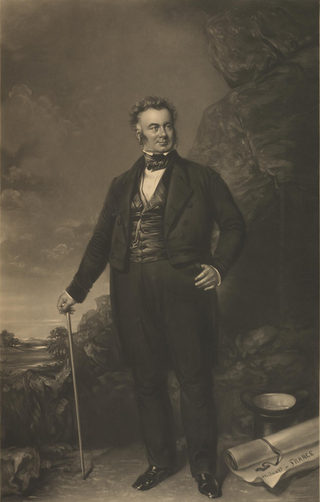Related Research Articles

Thomas Telford was a Scottish civil engineer. After establishing himself as an engineer of road and canal projects in Shropshire, he designed numerous infrastructure projects in his native Scotland, as well as harbours and tunnels. Such was his reputation as a prolific designer of highways and related bridges, he was dubbed the Colossus of Roads, and, reflecting his command of all types of civil engineering in the early 19th century, he was elected as the first president of the Institution of Civil Engineers, a post he held for 14 years until his death.

John Rennie was a Scottish civil engineer who designed many bridges, canals, docks and warehouses, and a pioneer in the use of structural cast-iron.

William Jessop was an English civil engineer, best known for his work on canals, harbours and early railways in the late 18th and early 19th centuries.

James Walker was an influential British civil engineer and contractor.

The London and Greenwich Railway (L&GR) was opened in London between 1836 and 1838. It was the first steam railway in the capital, the first to be built specifically for passengers, and the first entirely elevated railway.

James Meadows Rendel FRS was a British civil engineer.

Edward Ladd Betts was an English civil engineering contractor who was mainly involved in the building of railways.

Mythe Bridge carries the A438 road across the River Severn at Tewkesbury. It is a cast-iron arch bridge spanning 170 feet (52 m) and 24 feet (7.3 m) wide, designed by Thomas Telford and completed in April 1826. It is a Grade II* listed structure.
John Upton was born in Petworth, Sussex, England. He was a civil engineer and contractor working on roads, canals and ports first in England and later in Russia.

James Abernethy FRSE MICE was a Scottish civil engineer.

William Mackenzie was an Anglo-Scottish civil engineer and civil engineering contractor who was one of the leading European contractors in the 1840s.

Glasson Dock, also known as Glasson, is a village in Lancashire, England, south of Lancaster at the mouth of the River Lune. In 2011, it had a population of around 600.

Henry Robinson Palmer (1795–1844) was a British civil engineer who designed the world's second monorail and the first elevated railway. He is also credited as the inventor of corrugated metal roofing, still one of the world's major building materials.
John Gibb (1776–1850) was a Scottish civil engineer and contractor whose work included the construction of harbours, bridges, roads, lighthouses, and railways in the United Kingdom, primarily in Scotland. He was a close associate of Thomas Telford, who employed him on many of his civil engineering projects during the first half of the 19th century.

Charles Manby, FRS FRSA was Secretary of the Institution of Civil Engineers from November 1839 to 1856, and engineer of the first iron steamer to cross the English Channel. Fluent in French, he installed gas piping into Paris and advised on the construction of the Suez Canal.
John Timperley (1796-1856), was a British Civil engineer, active in dock work in the north and east of England and elsewhere - also the first recipient of the Telford Medal.
William Eassie (1805-1861) was a prominent Scottish businessman of the mid 19th century, working as a railway contractor and then as a Gloucester-based supplier of prefabricated wooden buildings.
John Armstrong was a British civil engineer who worked on a number of canals, bridges and tunnels, mostly in Bristol and London. From 1831 to 1854 he was the City Surveyor for Bristol.
Charles Jones was an English civil engineer, working primarily on canal tunnels. Despite Jones's extensive career working with prominent engineers on many waterways, he gained a reputation of unreliability and inability, and was dismissed from a number of projects.
Henry Eastburn (1753–1821) was a British draughtsman and civil engineer, known for his work on the canals of Great Britain, including the Basingstoke Canal, the Derwent and Rye navigations, and the Lancaster Canal.
References
- 1 2 3 4 5 6 "When London Became An Island: Hugh McIntosh (1768 -1840)". When London Became. Retrieved 13 October 2019.
- ↑ "Talk 4: Making a Canal" (PDF). Canal Museum. Retrieved 13 October 2019.
- ↑ M. M. CHRIMES (1994) Hugh McIntosh (1768–1840), National Contractor, Transactions of the Newcomen Society, 66:1, 175-192, DOI: 10.1179/tns.1994.008
- ↑ "Thomas Telford's Contribution". Gloucester Docks & the Sharpness Canal. Retrieved 13 October 2019.
- ↑ Mike, Chrimes (20 February 2016). "Hugh McIntosh and Goole". East Yorkshire local and family history. Retrieved 13 October 2019.
- ↑ Skempton, Alec (2002). A Biographical Dictionary of Civil Engineers in Great Britain and Ireland, Volume 1. London: Institution of Civil Engineers. p. 55. ISBN 9780727729392.
- ↑ "Mythe Bridge". Engineering Timelines. Retrieved 14 October 2019.
- ↑ "London Bridge". Kent Rail. Retrieved 13 October 2019.
- ↑ Telford, Thomas (2002). A Biographical Dictionary of Civil Engineers in Great Britain and Ireland. p. 420.